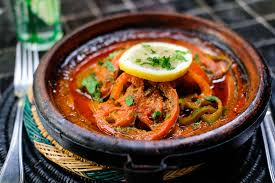The Flavours of Morocco: Exploring Traditional Moroccan Cuisine
When it comes to culinary delights, few places can rival the exotic and vibrant flavours of traditional Moroccan food. Rooted in a rich tapestry of history, culture, and geography, Moroccan cuisine is a tantalising fusion of Arab, Berber, and Mediterranean influences that have evolved over centuries.
A Feast for the Senses
At the heart of Moroccan cooking lies a deep appreciation for fresh ingredients, aromatic spices, and intricate flavour combinations. From savoury tagines to sweet pastries, each dish is a symphony of taste and texture that promises to transport you to the bustling souks and sun-soaked streets of Morocco.
Tagines: A Culinary Masterpiece
No discussion of traditional Moroccan food would be complete without mentioning the iconic tagine. Named after the earthenware pot in which it is cooked, a tagine typically features tender meat or vegetables simmered with a medley of spices such as cumin, saffron, and cinnamon. The slow cooking process allows the ingredients to meld together, creating a succulent and fragrant dish that is best enjoyed with fluffy couscous or crusty bread.
Couscous: The Grain that Unites
Couscous holds a special place in Moroccan cuisine as the cornerstone of many meals. This tiny grain is steamed to fluffy perfection and served as a base for stews, vegetables, or meats. Whether flavoured with raisins and almonds or paired with spicy harissa sauce, couscous embodies the essence of communal dining in Morocco.
Moroccan Pastries: Sweet Temptations
Indulge your sweet tooth with an array of delectable Moroccan pastries that are as beautiful as they are delicious. From honey-drenched baklava to almond-filled pastilla, these treats showcase the intricate craftsmanship and attention to detail that define Moroccan dessert culture. Wash it all down with a refreshing glass of mint tea for the perfect end to a meal.
Embracing Tradition in Every Bite
What sets traditional Moroccan food apart is not just its bold flavours but also the rituals and customs that surround it. Meals are often shared communally around a low table known as a ‘siniya’, where diners use their hands to scoop up morsels of food—a gesture that fosters connection and camaraderie among guests.
As you embark on your culinary journey through Morocco’s diverse regions—from the bustling markets of Marrakech to the coastal towns along the Mediterranean—you’ll discover that each dish tells a story steeped in tradition and heritage.
Bringing Morocco’s Flavours into Your Home
Ready to recreate the magic of traditional Moroccan cuisine in your own kitchen? Stock up on essential spices like ras el hanout, preserved lemons, and argan oil before delving into recipes for classic dishes such as lamb tagine with prunes or vegetable couscous. Let your senses guide you as you explore this culinary treasure trove from afar.
Whether you’re savouring a steaming bowl of harira soup on a cool evening or relishing the sweetness of date-filled ma’amoul cookies during festive occasions, traditional Moroccan food invites you to embrace its warmth and hospitality one bite at a time.
Exploring the Flavours of Morocco: Insights into Traditional Cuisine and Dining Culture
- What are the key ingredients used in traditional Moroccan cuisine?
- What is a tagine and why is it so popular in Moroccan cooking?
- How is couscous prepared in traditional Moroccan recipes?
- Can you explain the significance of mint tea in Moroccan dining culture?
- What are some common spices and herbs used in traditional Moroccan dishes?
- Are there any vegetarian or vegan options available in traditional Moroccan cuisine?
What are the key ingredients used in traditional Moroccan cuisine?
Traditional Moroccan cuisine is renowned for its rich and complex flavours, thanks to a harmonious blend of key ingredients that define its culinary identity. From the earthy warmth of cumin and the floral notes of saffron to the sweet tang of preserved lemons and the aromatic kick of fresh mint, Moroccan dishes are elevated by a carefully curated selection of spices, herbs, and condiments. Additionally, staple ingredients like couscous, olives, almonds, and dates play pivotal roles in creating the diverse array of tagines, pastries, and salads that grace Moroccan tables. These essential components not only add depth and character to each dish but also reflect the cultural heritage and vibrant spirit of Moroccan gastronomy.
What is a tagine and why is it so popular in Moroccan cooking?
A tagine is a traditional Moroccan dish named after the earthenware pot in which it is cooked. This iconic vessel features a cone-shaped lid that helps circulate and trap steam, allowing the ingredients to simmer slowly and infuse with the rich blend of spices. The popularity of tagine in Moroccan cooking lies in its ability to create tender, flavourful dishes that showcase the essence of Moroccan cuisine. By combining succulent meats, vegetables, dried fruits, and aromatic herbs, the tagine captures the diverse flavours of Morocco in each savoury bite. Its communal serving style and ability to bring people together around a shared meal make it a beloved symbol of hospitality and tradition in Moroccan culture.
How is couscous prepared in traditional Moroccan recipes?
In traditional Moroccan recipes, couscous is prepared with meticulous care and attention to detail, reflecting the essence of Moroccan culinary traditions. The process begins by steaming the tiny grains of couscous until they are light and fluffy, creating a perfect base for a variety of flavourful ingredients. Typically, couscous is paired with a fragrant stew made from tender meats, seasonal vegetables, and an array of aromatic spices such as cumin, turmeric, and paprika. This harmonious combination results in a dish that not only delights the taste buds but also embodies the spirit of communal dining in Morocco, where sharing a meal is a cherished ritual that brings people together around a table laden with delicious food and warm hospitality.
Can you explain the significance of mint tea in Moroccan dining culture?
In Moroccan dining culture, mint tea holds a revered place as a symbol of hospitality, tradition, and social connection. Known as “atay nana” or “Moroccan whiskey,” this sweet and aromatic tea is more than just a beverage—it is a ritual that brings people together. Served in ornate tea glasses and poured from a height to create froth, mint tea is offered to guests upon arrival as a gesture of welcome and respect. The refreshing blend of green tea, fresh mint leaves, and sugar not only cleanses the palate but also encourages conversation and bonding among diners. Whether enjoyed in bustling souks or serene riads, mint tea embodies the warmth and generosity that define Moroccan hospitality.
What are some common spices and herbs used in traditional Moroccan dishes?
In traditional Moroccan cuisine, a vibrant palette of spices and herbs plays a pivotal role in creating the distinctive flavours that define the country’s culinary identity. Cumin, paprika, cinnamon, and ginger are just a few of the essential spices that lend depth and warmth to dishes like tagines and couscous. Herbs such as parsley, coriander, and mint add freshness and complexity to savoury recipes, while saffron infuses a golden hue and delicate floral notes to special dishes. The judicious blend of these aromatic ingredients showcases Morocco’s mastery in balancing bold flavours with subtle nuances, inviting diners on a sensory journey through its diverse culinary landscape.
Are there any vegetarian or vegan options available in traditional Moroccan cuisine?
In traditional Moroccan cuisine, there are indeed plentiful vegetarian and vegan options that showcase the diversity and creativity of the country’s culinary heritage. From flavourful vegetable tagines bursting with spices and herbs to hearty couscous dishes brimming with seasonal produce, vegetarians and vegans can delight in a myriad of dishes that cater to their dietary preferences. Additionally, Moroccan cuisine offers delectable salads, soups, and appetisers made from fresh ingredients such as chickpeas, lentils, and a colourful array of vegetables, ensuring that plant-based eaters can savour the authentic flavours of Morocco without compromising on taste or tradition.



